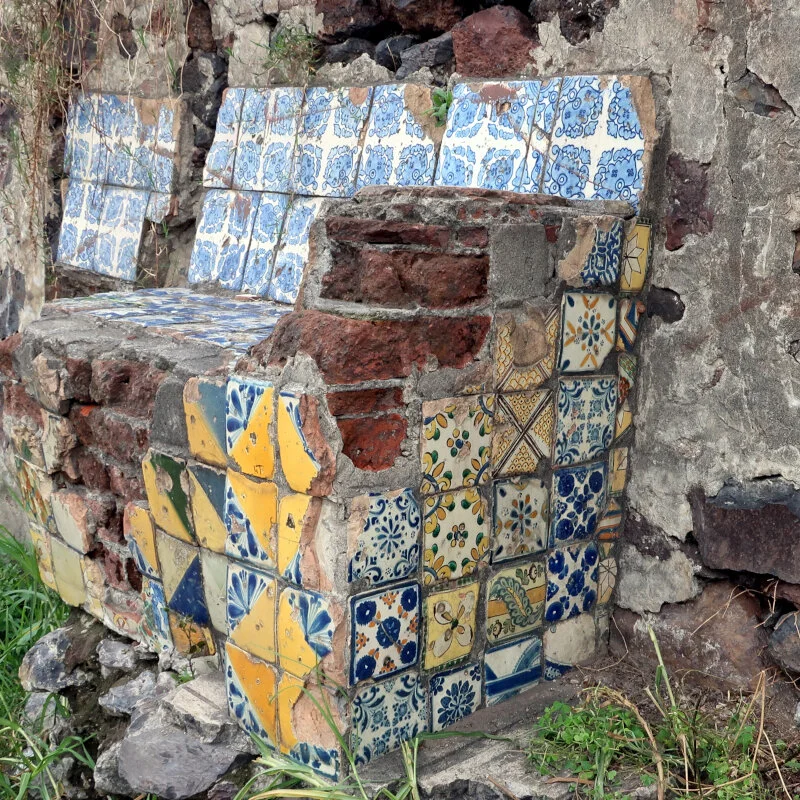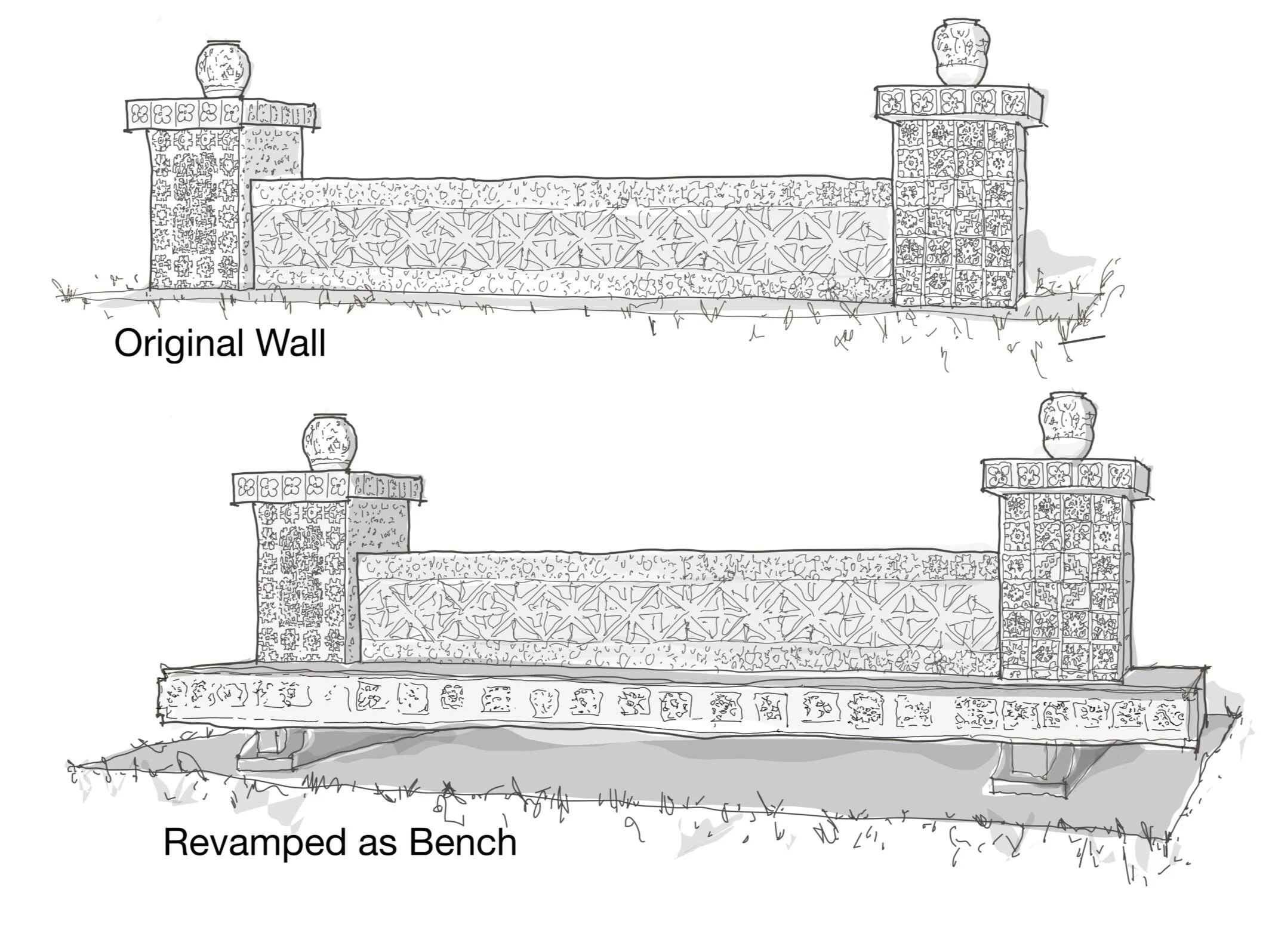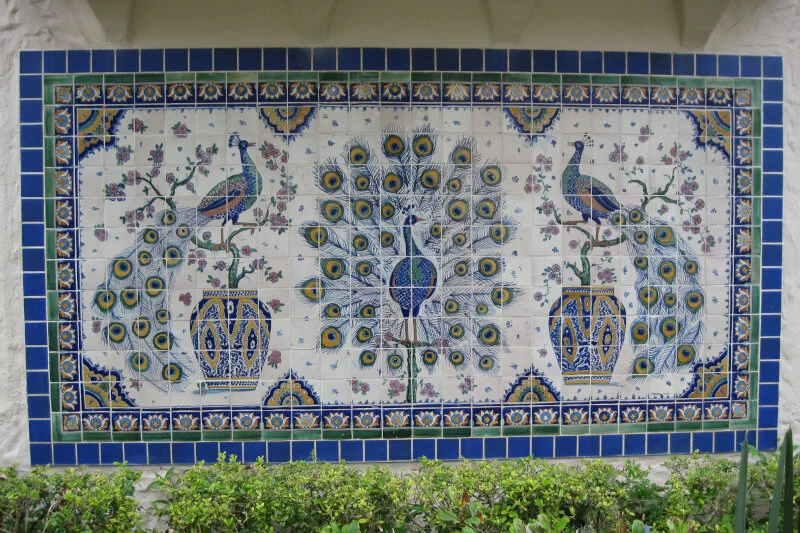For the Love of Talavera
Clay and Color: A Bridge between Men
In 1920s San Antonio, only one person loved colorful Mexican tile as much as Urrutia—Atlee B. Ayres. After his graduation from architecture school in Manhattan, Ayres took his first job in Mexico City in 1896, working a year for architect George King. Perhaps he had occasion to sit on the pre-revolutionary Talavera benches at Urrutia’s Xochimilco hacienda, but more likely, the two men met stateside.
In 1918, Ayres certainly saw Urrutia’s stunning Spanish-style mansion, Quinta Urrutia, with its ten-thousand-square-foot footprint, going up on Broadway. It dwarfed the nearby conventional wood-frame bungalows of Mahncke Park and made a statement of Mexican residential style unprecedented in San Antonio at the time. Brackenridge Park served as a backdrop to this relatively undeveloped stretch of River Avenue. Mexican tile was used indoors and out at the house, from its beautifully patterned pressed concrete tile floors to its Talavera wall murals and decorative mosaic features.
Late 19th century Xochimilco bench in ruins. Photo by Anne Elise Urrutia, 2018.
Seatwall on a snowy day at Quinta Urrutia. Urrutia Photo Collection, all rights reserved.
A few Urrutia daughters seated on the edge of a fountain pool in the Quinta Urrutia courtyard. Urrutia Photo Collection, all rights reserved.
So great was Ayres’s love for Mexico, and so resourceful and social was he, that it would have been out of character for him not to meet Urrutia or the Quinta Urrutia architect, Porfirio Treviño, of Monterrey, Mexico. Ayres, who was just ending his stint as state architect, was getting ready to enter the prime of his architectural career in San Antonio. He would have noticed Urrutia’s collection of Talavera seat walls, placed at intervals in the Quinta Urrutia garden, near the entrance to the house. These rectangular structures were freestanding in the lawn, capped at the ends by slightly taller columns or punctuated by an urn planter perched at the center. Formed from brick and concrete, and clad in hundreds of colorful azulejos, the seats, more than two feet high and fifteen feet long, accommodated eight, ten, or twelve people and often served as a backdrop for photographs of the Urrutia family as they came and went from the home.
Seatwalls at Quinta Urrutia; conversion to bench at Miraflores. Illustration by Rebecca Schenker, © Anne Elise Urrutia.
Urrutia purchased the land for Miraflores in 1921 and began to make Talavera tile-work a unifying feature of the garden by using it extensively in the two entrance gates—one on Hildebrand and one on Broadway. Urrutia relocated at least three massive seat walls from Quinta Urrutia to Miraflores, a mile away, re-purposing them into larger and grander raised bench designs. The wall of each of the house’s seats became the backrest to a new bench at Miraflores, where it was lifted onto a wider horizontal slab seat set on legs.
Urrutia went on to design at least eight different Talavera benches to carry the theme throughout the garden. Some were freestanding, others were incorporated into the architecture, and still others were nestled into more naturalistic locations. The benches added a ribbon of color and unity to the garden, and gave visitors ample places to sit and contemplate the natural beauty around them.
Ayres became quite obsessed with Urrutia’s collection of Talavera tiles, some of them antiques, and Mexican tile in general. Urrutia’s use of many types of Mexican tile in his home on Broadway and in the gates and benches of Miraflores was highly unusual, even unprecedented, in San Antonio, as colorful Mexican tile and white stucco was not yet a feature of its homes at the time. In the early to mid-1920s, the Talavera workshops of Puebla were emerging from a long period of decline, and their work was rare, expensive, and collectible. The origins and history of Talavera tile in colonial Mexico had only recently been academically explored, as the Philadelphia Museum and the Metropolitan Museum of Art in New York began their collections between 1906 and 1916.
The rebirth of the Talavera industry allowed Urrutia and Ayres to delve full force into designing with tile, each in their own way. As Urrutia built his home in 1918, Ayres traveled to California to learn about the blossoming Spanish Colonial Revival home-building trend. And as Urrutia incorporated his Talavera collection into Miraflores between 1921 and 1925, Ayres traveled to Spain, and then to interior Mexico to work on his 1926 book Mexican Architecture. During his time in Mexico, Ayres procured a photograph of the new tile benches of the Fuente del Quijote in Mexico City’s central park, Bosque de Chapultepec, in addition to documenting many other uses of tile for his book.
Talavera mural, McNay courtyard. Photo by the author, ©2017.
Today, if you go to the McNay Art Museum, in the beautiful interior courtyard you will see a tile peacock wall panel from the Uriarte Talavera workshop in Puebla, used by Ayres in 1927. It is similar to the one Urrutia used on the Urrutia arch at Miraflores in 1924. Ayres also incorporated tile benches of his own design into a few of his Spanish Colonial Revival homes.
In 1930, as business slowed during the Great Depression, Ayres became more focused on his photography hobby. One Sunday he set out to photograph the tile seats at Miraflores, hoping to try to sell his images to a publisher. In a pitch introducing himself as “an amateur photographer” who had recently gone “out on a little photographing tour,” he wrote: “We have in San Antonio a man by the name of Dr. Urrutia, who came here from the City of Mexico some few years ago. He has quite a good size piece of property on the outskirts of town and has built up a lot of pools, gardens, etc. . . . He is quite an artistic fellow and collected a lot of beautiful antique tile which he has used in a most interesting way in building up seats around his pools, fountains, etc. They are most colorful and original.”
Urrutia collaborated with Ayres as the architect tried to place the photographs with five architecture magazines. The doctor penned detailed descriptions and even fable-like stories about the various seats. Their work, however, was rejected.
Then, in March 1931, Ayres was appointed to the committee tasked with hosting the annual American Institute of Architects (AIA) convention to be held that April in San Antonio. Mrs. Ayres (née Olive Moss) approached Urrutia to ask if the spouses of the architects could visit Miraflores. He not only enthusiastically agreed but also invited the entire convention for a late afternoon visit and evening fiesta at Miraflores. The architects pronounced the party—which featured performances by costumed Mexican dancers, singers, and a string orchestra, followed by a dinner of traditional Mexican food—“one of the most interesting and colorful that they had ever attended.” Indeed, most of the attendees, who came from all over the United States, had never before been exposed to any aspect of Mexican culture. The tradition of Mexican fiesta was relatively unknown in the United States at that time. A correspondent from American Architect magazine commented to Ayres that he would “remember the Convention . . . long after many other conventions [were] forgotten.”
Arts & Architecture, June 1932, ©Travers Family Trust.
The institute presented Urrutia with a hand-illuminated parchment scroll in thanks. That year, riding on the success and recognition of the convention, Ayres became the first San Antonio architect to receive an AIA fellowship. Shortly thereafter Ayres received an invitation to publish his photographs of Urrutia’s benches in California Arts and Architecture. Because of the Depression, the magazine could only offer Ayres a two-year subscription in compensation. After more than two years of pitching the photos, Urrutia saw his eight tile benches, photographed by his co-enthusiast Atlee B. Ayres, published in 1932 in a striking two-page spread.
Although each man was impressive in his respective field, together the two went above and beyond to build an early bridge between their cultures. Urrutia’s bold expressions of Quinta Urrutia and Miraflores at least partially inspired Ayres to move toward an architectural style that changed San Antonio. Ayres’s act of publishing Urrutia’s benches and showcasing his home and garden to architects nationwide acknowledged Urrutia’s influence on his thinking. Perhaps even more importantly, their shared love of Mexico and their creativity allowed them to find a way to collaborate. Each validated the other’s thoughts that San Antonio’s connection with Mexico was important, and that if they built on it they could reconnect to Mexico in a special way to create places of unique beauty.
This essay, “For the Love of Talavera,” is excerpted from Anne Elise Urrutia’s book, Miraflores: San Antonio’s Mexican Garden of Memory. The Urrutia Arch is held by the San Antonio Museum of Art.
All photographs by Anne Elise Urrutia, unless otherwise noted. All rights reserved and used with permission.
Posted on September 12, 2021. Republished on October 28, 2022.






